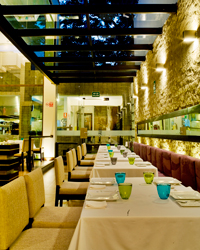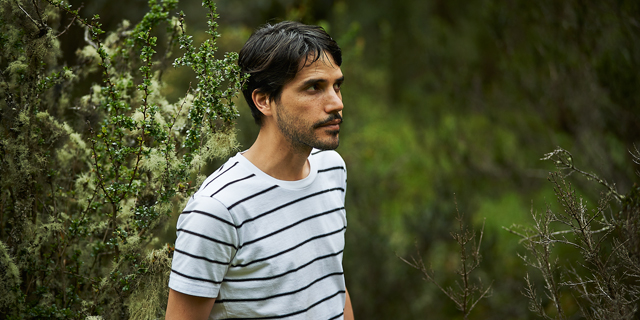Standing on the second floor of Central, I watched as the waiter below walked near soundlessly in-between the white decked tables, gently pressing down on the corner of each one. It’s all about the little details and every last one was checked and polished; in five minutes the doors of Peru’s best restaurant would open and let in another Saturday night.
This is the heart of Virgilio Martínez’s young restaurant empire, one that is certain to leave a lasting impression on the Peruvian culinary scene. Virgilio is a self-confessed fanatic of the investigatory side of cooking, a firm believer in exploring the furthest reaches of Peru’s astounding biodiversity and there seeking inspiration for his constantly changing menus. His passion for cooking and creating a deeper eating ‘experience’ is paying off and his star has been rising quickly. After working in top kitchens throughout Europe and then spending a long stint under Gaston Acurio in Astrid y Gaston, he opened up his first restaurant, Central. That was only three years ago.
Now he has two more, Senzo in Cusco and the recently opened Lima on London. Central was included in the 2013 World’s 50 Best Restaurants list and there is talk of a 2014 collaboration between him and Gaston Acurio in London, an intimate space to display the very best of Peru. In between all this, he is finding time to get married to girlfriend and executive chef in Central, Pia Leon, and take a few days for a honeymoon to Mexico, where his only interaction with food will be eating it.
Here, the culinary superstar talks about his inspiration, his newfound success, and what comes next.
[ pagebreak ]TLK: What did it mean to you, opening a restaurant in London?
Virgilio: I feel a bit of everything: gratitude, pride, satisfaction. It has meant a lot for our venture; even though Lima London is more casual and smaller, it has been a real pleasure to be able to present our culture, to share our ideas, our flavors.

Virgilio: This is how we used to tell Peru’s story in our cuisine, a baroque style but with modern techniques. Now we have a message that, while complex – because of the complexity of the biodiversity of Peru – focuses on simplicity and naturalism. The use of technical cooking continues, but under an umbrella of simplicity. Magic and emotion play a large part in achieving memorable experiences.
TLK: If you had to assign a flavor or characteristic to each of the ‘gastronomic regions’ of Peru, what would that be? (One of Virgilio’s best known creations is a tasting menu that takes diners on a gastronomic tour of Peru. He was invited to recreate this menu for the recent World’s 50 Best awards.)
Virgilio: For thehe sea: greatness, wealth, life. Flavors: salt, umami, the taste of a live scallop. For the coast – fun, centralization of concepts. Flavors: Spicy and acidic. For the Lower Andes – native products. Flavors: Minerality, vegetable, grass. For the High Andes – Roots, the unknown. Flavors: Fresh, clean air, subtle, nearly neutral flavors. For the High jungle – biodiversity. Flavors: Herbaceousness, salt. For the Amazon – mysticism, herbs, surprises, the unknown. Flavors: Fermentation
[ pagebreak ]
TLK: You have an impressive collection of various types of salt, could you choose three favorites?
Virgilio: I love Maras salt (the pink Andean salt from Maras in the Sacred Valley near Cusco) – with potatoes from the high Andes; Sea salt from Piura – with crumbed seafood; and Brown Andean salt – we cook all our dishes with it.
TLK: You are known as a great investigator of local products and you’re part of a very interesting project, ‘Mater,’ tell us a little 
Virgilio: It’s something we have had pending for a while, getting together various disciplines and groups of friends and documenting our travels as we discover new products. The idea is to include people who are not necessarily involved with Central. Mater joins us and serves as a guide, it allows us to reach more people, more ideas, more concepts; this is pure research and a desire to understand our environment.
TLK: Are you developing something new in your lab can you tell us about? (He has a glass walled lab on the second floor where diners can peek into his world of research. It is piled high with barks, rocks and hunks of salt.)
Virgilio: We are going to start using Amazonian algae, and mushrooms, but they’re still going through the lab. We are also studying Amazonian woods, which produce things as yet unknown in the gastronomic and artistic world. Putting them on the plate and within the eating experience is a challenge; we already discarded several which are hallucinogenic or even fatal, so we have to be very careful.
TLK: Do you have a favorite food memory?
Virgilio: Veal sweetbreads on a homemade barbecue, and soaking up the blood and juices of roasted beef with a slice of bread.


![Making Mealtime Matter with La Familia: Easy Sofrito [Video]](https://thelatinkitchen.com/wp-content/uploads/2015/10/sofrito-shutterstock__0-500x383.jpg)
![Easy Latin Smoothies: Goji Berry Smoothie [Video]](https://thelatinkitchen.com/wp-content/uploads/2015/12/goji_berry-shutterstock_-500x383.jpg)
















![Fun and Fast Recipes: Fiesta Cabbage Salad [Video]](https://thelatinkitchen.com/wp-content/uploads/2015/11/fiesta_cabbage_slaw-shutterstock_-500x383.jpg)









